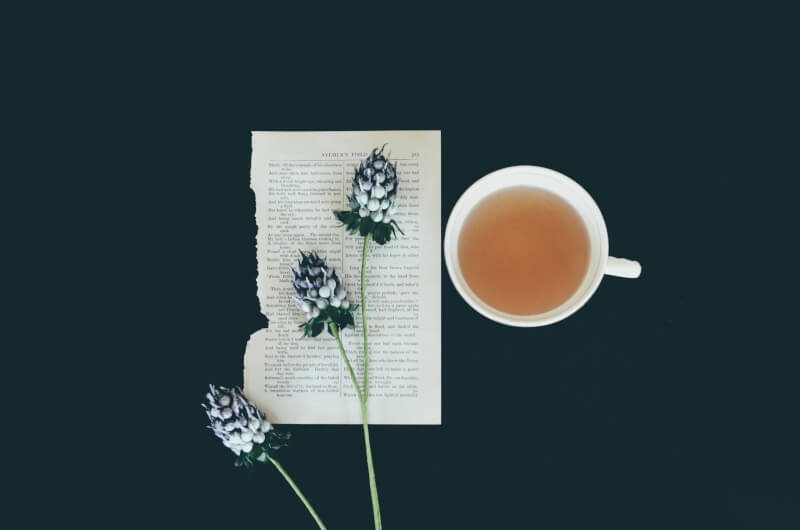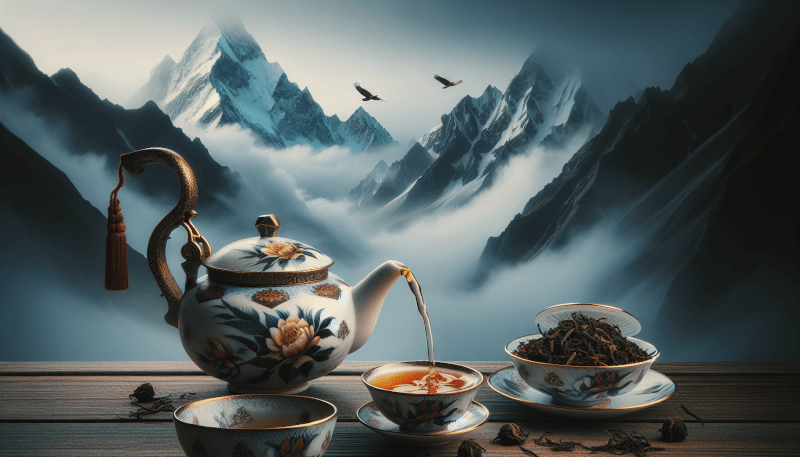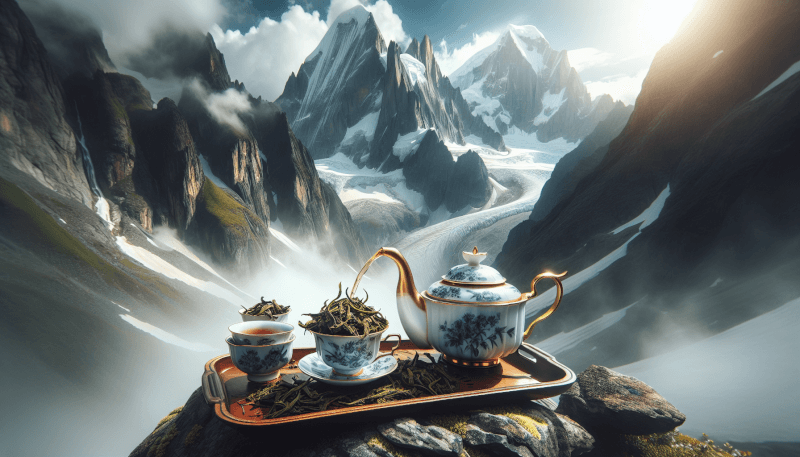If you find yourself at high altitudes and are wondering how to brew the perfect cup of tea, you’re in luck! This article will provide you with the best practices for tea brewing at high altitudes. With the air thinner and the water boiling at a lower temperature, it’s important to adjust your brewing techniques to achieve the optimal flavor and aroma. Whether you’re a tea aficionado or simply looking for a delicious cup to enjoy, these tips will help you navigate the challenges of brewing tea at high altitudes.

Choosing the Right Tea Leaves
When it comes to brewing tea at high altitudes, choosing the right tea leaves is crucial. Altitude plays a significant role in determining the flavor and aroma of tea. Tea plants cultivated at high altitudes face harsher growing conditions, such as cooler temperatures and thinner air, which result in slower growth and higher levels of antioxidants in the leaves.
Consideration of Altitude
Different altitudes produce different tea flavors and qualities, so it’s important to consider the altitude at which the tea leaves were grown. Higher altitudes, typically above 3,000 feet, tend to produce teas with more delicate flavors and complex aromas. On the other hand, teas grown at lower altitudes may have a stronger and bolder taste.
Tea Varieties Suitable for High Altitudes
Certain tea varieties thrive in high-altitude environments and are renowned for their exceptional quality. Some examples include Darjeeling, Nepal, and Himalayan teas. These teas are known for their floral and muscatel notes, which are the result of the unique growing conditions found at higher altitudes.
Freshness of Tea Leaves
Whether you’re brewing at high altitudes or not, the freshness of the tea leaves is of utmost importance. Opt for tea leaves that have been recently harvested and properly stored. Fresher leaves tend to produce a more vibrant and flavorful brew, making your high-altitude tea experience truly exceptional.
Water Quality and Temperature
The quality of water used for brewing tea can greatly impact the final result. At high altitudes, it becomes even more crucial to pay attention to water quality and temperature to ensure the best possible flavor extraction.
Using Pure Water
Using pure, filtered water is highly recommended when brewing tea at high altitudes. Tap water, especially in certain areas, can contain impurities or minerals that might alter the taste of your tea. Opting for purified or filtered water ensures a clean and neutral base for brewing, allowing the true flavors of the tea to shine through.
Adjusting Water Temperature
Altitude affects the boiling point of water, causing it to boil at lower temperatures than at sea level. It’s important to adjust the water temperature accordingly to achieve optimal results. As a general rule of thumb, at higher altitudes, reduce the water temperature by 1-2 degrees Celsius for each 1,000 feet of elevation. This adjustment compensates for the lower boiling point and prevents over-extraction or bitterness in your tea.

Tea-to-Water Ratio
Finding the right tea-to-water ratio is essential for brewing a perfectly balanced cup of tea. This ratio has an impact on the strength and flavor of your brew and can be adjusted based on personal preference and altitude.
Finding the Optimal Ratio
A common starting point for tea brewing is using one teaspoon of loose tea leaves for every 8 ounces (approximately 240 milliliters) of water. However, this ratio can be adjusted to suit your taste. Experimenting with different ratios can help you achieve the perfect balance between strength and delicacy based on your altitude and desired flavor profile.
Adjusting for Altitude
When brewing tea at higher altitudes, you may need to slightly increase the amount of tea leaves used to compensate for the potential loss of flavor due to reduced pressure. Increasing the tea leaves by a small amount can help achieve a more robust and flavorful brew.
Preheating the Teapot
While often overlooked, preheating the teapot is a simple yet crucial step in brewing tea at any altitude. Preheating helps to ensure an even distribution of heat and maintain the optimum brewing temperature throughout the steeping process.
Importance of Preheating
Preheating the teapot helps to prevent temperature fluctuations when the boiling water is added. This consistent temperature allows the tea leaves to steep evenly and extract their flavors more effectively, resulting in a well-balanced brew. Preheating also warms up the teapot, preventing the tea from cooling too quickly as it is poured.
Methods for Preheating
There are a few different methods you can use to preheat your teapot. One common method is to fill the teapot with hot water and let it sit for a minute or two before discarding the water. Another method is to pour boiling water into the teapot, swirl it around, and then pour it out. Whichever method you choose, the goal is to warm up the teapot before adding the tea leaves and water for steeping.

Time and Steeping Techniques
The steeping time and techniques play a critical role in extracting the desired flavors and aromas from the tea leaves. Different types of tea require different steeping times and methods to achieve the best results, especially when brewing at higher altitudes.
Determining Steeping Time
The recommended steeping time can vary depending on the type of tea you’re brewing. It’s always best to follow the instructions provided with your specific tea and adjust as necessary based on your altitude. As a general guideline, delicate teas like green or white teas require shorter steeping times, typically between 1-2 minutes, while black teas may require longer steeping times, usually around 3-5 minutes.
Alternative Steeping Techniques
If you prefer a stronger brew or want to experiment with different flavors, you can try alternative steeping techniques such as multiple short steeps or grandpa-style brewing. Multiple short steeps involve steeping the tea leaves for shorter durations but repeating the process multiple times. Grandpa-style brewing involves steeping the leaves directly in a cup without a separate infuser. These techniques can enhance the complexity of the flavor profile and allow you to enjoy the evolving taste of the tea with each consecutive steep.
Teaware Considerations
Choosing appropriate teaware is not only about aesthetics but also about functionality and enhancing the overall tea brewing experience, especially at high altitudes.
Choosing Appropriate Teaware
When selecting teaware for brewing at high altitudes, consider materials that offer good heat retention, such as ceramic or cast iron. These materials help to maintain a more stable brewing temperature throughout the steeping process, allowing for a more consistent and flavorful brew.
Insulated Teaware for High Altitudes
Insulated teapots or tea cups can be particularly useful when brewing at high altitudes. The insulation helps to retain heat for a longer period, preventing the tea from cooling too quickly and allowing for a more prolonged and enjoyable tea sipping experience. Consider investing in a double-walled teapot or a thermally insulated tea cup to make the most of your high-altitude tea brewing sessions.

Storage of Tea Leaves
Proper storage of tea leaves is crucial to maintain their freshness, flavor, and aroma, regardless of the altitude at which they will be brewed.
Proper Storage Conditions
To ensure the longevity of your tea leaves, store them in airtight containers away from strong odors, moisture, and direct sunlight. Exposure to air, light, and humidity can lead to staleness and flavor degradation. Consider using glass jars or tin containers with airtight lids to keep your tea leaves at their best for as long as possible.
Avoiding Moisture and Sunlight
Moisture is the enemy of tea freshness, so make sure to store your tea leaves in a dry place away from sources of moisture, such as kitchens or bathrooms. Sunlight can also degrade the quality of tea leaves, so it’s best to keep them in a cool and dark location. By avoiding moisture and sunlight, you can preserve the flavors and aromas of your tea leaves, allowing you to enjoy a refreshing cup every time.
Factors Affecting Brew at High Altitudes
Brewing tea at high altitudes presents unique challenges due to the changes in atmospheric pressure, temperature variations, and humidity levels. It’s essential to be aware of these factors and adapt your brewing techniques accordingly.
Reduced Atmospheric Pressure
At higher altitudes, the reduced atmospheric pressure affects the boiling point of water and alters the brewing process. Lower pressure can make it more challenging to achieve the desired extraction of flavors from the tea leaves. By adjusting variables such as water temperature, steeping time, and tea-to-water ratio, you can optimize your brewing process to compensate for the decreased pressure and achieve a satisfactory cup of tea.
Temperature Variations
Temperature variations are common at high altitudes, and they can impact the brewing process. As mentioned earlier, water boils at lower temperatures at higher altitudes, which affects the extraction of flavors from the tea leaves. Monitoring water temperature and adjusting it accordingly is essential for achieving a well-balanced and flavorful brew.
Humidity Levels
Humidity levels can also vary at different altitudes, affecting the moisture content of the tea leaves and the overall brewing process. Higher humidity levels can cause the tea leaves to absorb excess moisture, leading to a less flavorful brew. It’s important to store your tea leaves properly and take into account the humidity levels when determining steeping times and tea-to-water ratios.

Taste and Flavor
Brewing tea at high altitudes can result in unique taste and flavor profiles due to the interplay of various factors. Understanding this interaction and experimenting with different techniques can help you achieve a well-rounded and satisfying cup of tea.
Balance of Strength and Delicacy
Tea brewed at high altitudes tends to have a delicate and nuanced flavor profile. It’s important to find the right balance between strength and delicacy based on personal preference and altitude. Adjusting steeping times, tea-to-water ratios, and water temperatures can help you achieve the desired level of flavor intensity while still maintaining the underlying delicate notes of the tea.
Enhancing Flavor with High Altitude Brewing
Brewing tea at high altitudes can bring out unique flavors and aromas that are characteristic of teas grown in such environments. The combination of cooler temperatures, reduced pressure, and specific growing conditions contributes to the distinctive flavor profiles. Embrace the opportunity to savor these nuances and enjoy the heightened flavors that high-altitude brewing can offer.
Special Considerations for Herbal and Green Teas
Herbal and green teas require special attention when brewing at high altitudes due to their delicate nature and lower processing temperatures.
Lower Temperature and Shorter Steeping Times
Green teas and certain herbal teas should be brewed at lower temperatures to avoid bitterness and preserve their delicate flavors. When brewing at high altitudes, it’s important to further reduce the water temperature and shorten the steeping times to achieve the desired result. Experimentation will help you find the perfect balance for your herbal and green teas at your specific altitude.
Reducing Bitterness in Herbal and Green Teas
Bitterness in herbal and green teas can be a challenge when brewing at high altitudes. To minimize bitterness, consider using slightly cooler water, reducing the steeping time, or adjusting the tea-to-water ratio. This will help prevent over-extraction and ensure a more pleasant and balanced cup of herbal or green tea.
Brewing tea at high altitudes offers a wonderful opportunity to explore unique flavors and aromas. By considering the altitude, adjusting water quality and temperature, finding the right tea-to-water ratio, preheating the teapot, mastering the steeping techniques, choosing appropriate teaware, and properly storing the tea leaves, you can elevate your tea brewing experience to new heights. Embrace the challenges and possibilities that brewing at high altitudes presents, and savor the delightful cups of tea that await you. Cheers to a perfectly brewed cup of high-altitude tea!


